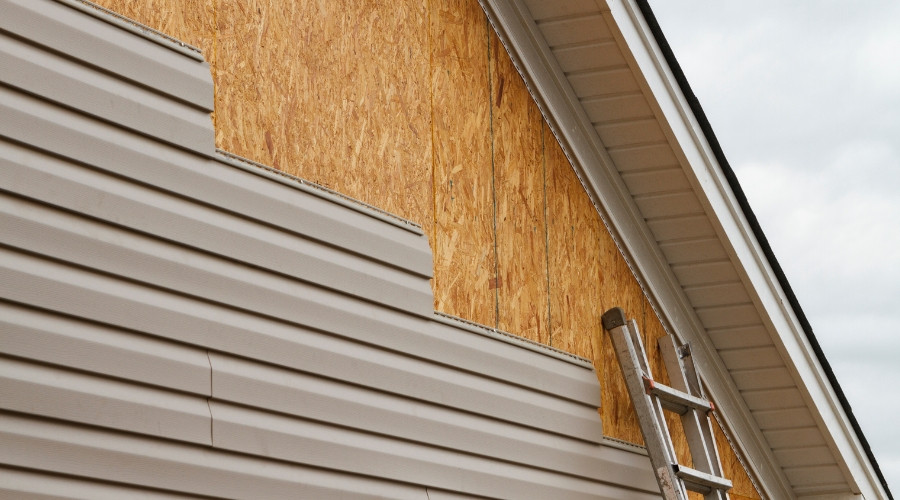Signs Siding Repair Is Needed
Deciding when to repair the home’s siding can feel uncertain, but knowing what to look for makes the process far easier. This guide outlines clear warning signs—from visible exterior damage and water stains to rising energy bills—so timely action can protect the structure, preserve curb appeal, and restore the performance of the exterior cladding.
Visible Cracks and Damage
 The exterior tells a story about the condition of the building envelope. Siding repair becomes urgent when holes, cracks, or loose panels appear, as these defects compromise the protective barrier, inviting moisture intrusion and pest infestations. Warped or buckling sections often indicate trapped moisture behind the cladding, while panels pulling away from the wall signal fastener failure or shifting substrates that allow gaps to form.
The exterior tells a story about the condition of the building envelope. Siding repair becomes urgent when holes, cracks, or loose panels appear, as these defects compromise the protective barrier, inviting moisture intrusion and pest infestations. Warped or buckling sections often indicate trapped moisture behind the cladding, while panels pulling away from the wall signal fastener failure or shifting substrates that allow gaps to form.
Faded or peeling surfaces are more than cosmetic concerns; they can point to weathered coatings and reduced resistance to the elements. Bubbling, splitting, and irregular seams may reveal that the underlying materials are stressed or wet. Even small openings can channel water behind the siding, leading to rot, swollen sheathing, and damaged framing. Once deterioration begins, progression can be rapid, especially through seasonal freeze-thaw cycles or heavy wind-driven rain.
A systematic inspection during seasonal maintenance helps catch issues before they spread. Where damaged sections exist, prompt siding repair or replacement of affected panels reestablishes the weather-resistant barrier and prevents more extensive—and costly—restoration later. Addressing fasteners, trims, and sealants simultaneously ensures the entire cladding system functions as intended.
Water Stains or Mold
 Discoloration and fungal growth are common warning signs of moisture reaching places it shouldn’t. Water stains—often appearing as brownish, yellowish, or dark streaks—indicate that water is migrating behind the exterior cladding. Mold growth along seams, near the foundation, or around windows points to leaks, failing caulk, damaged flashing, or cracked panels that allow water penetration.
Discoloration and fungal growth are common warning signs of moisture reaching places it shouldn’t. Water stains—often appearing as brownish, yellowish, or dark streaks—indicate that water is migrating behind the exterior cladding. Mold growth along seams, near the foundation, or around windows points to leaks, failing caulk, damaged flashing, or cracked panels that allow water penetration.
Moisture problems rarely remain on the surface. Once water moves behind siding, it can saturate sheathing, reduce insulation effectiveness, and create conditions that encourage rot and mold growth. In addition to discoloration, look for soft spots, spongy areas, or swelling around joints and trims. These indicators suggest deeper water damage that needs attention before it spreads to interior materials.
Correcting the cause is as important as addressing the symptom. A professional assessment can identify whether the source is failed flashing at roof-wall intersections, compromised house wrap, gaps at penetrations, or deteriorated joints. From there, targeted siding repair, new flashings, improved sealants, and proper drainage detailing help stop recurring water stains and preserve the durability of the cladding system.
Higher Energy Bills
Unexpectedly higher energy bills or fluctuating utility bills may signal that exterior walls are no longer performing as designed. Gaps, cracks, and warped siding panels can create air pathways that allow conditioned air to escape while outdoor air infiltrates the living space. Over time, moisture behind cladding can also compress or dampen insulation, reducing thermal performance and driving HVAC systems to cycle more often.
Signs of reduced efficiency include drafty rooms, uneven temperatures, or equipment that runs longer than usual. While several factors can affect comfort and energy costs, compromised siding is a frequent contributor. When panels are loose or seams aren’t sealed, the thermal boundary is weakened, and the building envelope loses its ability to resist heat gain in summer and heat loss in winter.
Siding repair directly addresses these efficiency concerns. Replacing damaged sections, re-securing panels, improving flashing and sealant details, and ensuring proper underlayment can restore the continuity of the exterior envelope. In cases of widespread deterioration, a planned siding replacement can integrate modern cladding materials, correct moisture management, and update weather barriers—helping stabilize energy bills and enhance long-term performance.
By watching for visible damage, responding to water stains and mold at the first sign, and investigating persistent spikes in utility bills, homeowners can safeguard the structure and extend the life of the home’s siding. Proactive maintenance and timely siding repair of the cladding system protect against moisture, improve comfort, and prevent small problems from becoming major projects.
Call JBX Roofing
JBX Roofing offers reliable, full-service roofing services throughout Philadelphia and its surrounding communities. They provide free estimates and top-rated service from friendly, professional technicians. Call them today to schedule siding services in Philadelphia, PA.




